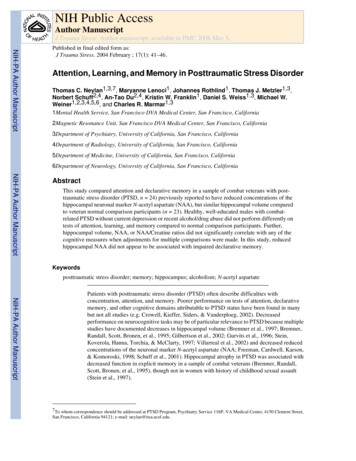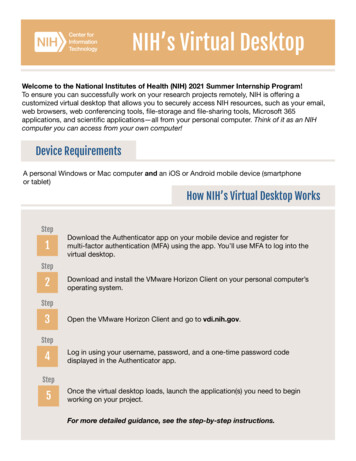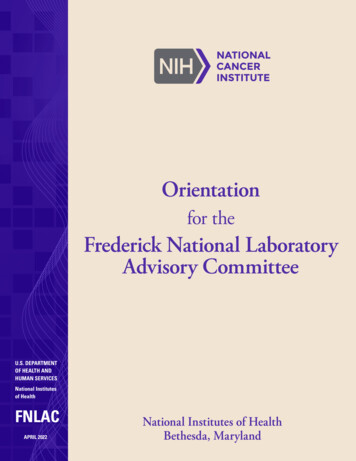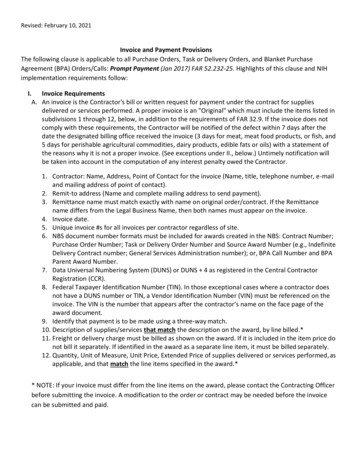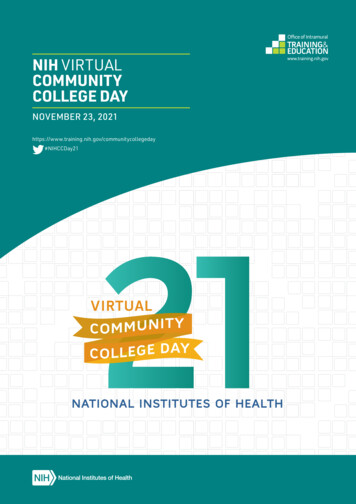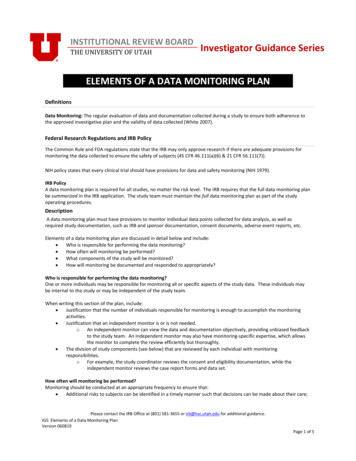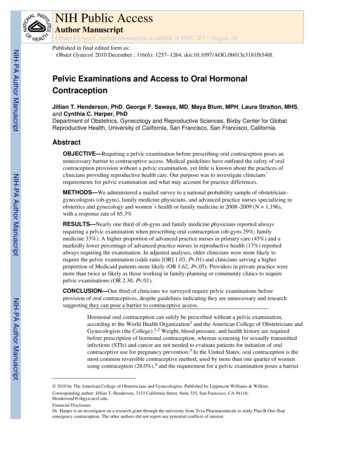
Transcription
NIH Public AccessAuthor ManuscriptObstet Gynecol. Author manuscript; available in PMC 2013 August 16.NIH-PA Author ManuscriptPublished in final edited form as:Obstet Gynecol. 2010 December ; 116(6): 1257–1264. doi:10.1097/AOG.0b013e3181fb540f.Pelvic Examinations and Access to Oral HormonalContraceptionJillian T. Henderson, PhD, George F. Sawaya, MD, Maya Blum, MPH, Laura Stratton, MHS,and Cynthia C. Harper, PhDDepartment of Obstetrics, Gynecology and Reproductive Sciences, Bixby Center for GlobalReproductive Health, University of California, San Francisco, San Francisco, California.AbstractNIH-PA Author ManuscriptOBJECTIVE—Requiring a pelvic examination before prescribing oral contraception poses anunnecessary barrier to contraceptive access. Medical guidelines have outlined the safety of oralcontraception provision without a pelvic examination, yet little is known about the practices ofclinicians providing reproductive health care. Our purpose was to investigate clinicians′requirements for pelvic examination and what may account for practice differences.METHODS—We administered a mailed survey to a national probability sample of obstetrician–gynecologists (ob-gyns), family medicine physicians, and advanced practice nurses specializing inobstetrics and gynecology and women′s health or family medicine in 2008–2009 (N 1,196),with a response rate of 65.3%RESULTS—Nearly one third of ob-gyns and family medicine physicians reported alwaysrequiring a pelvic examination when prescribing oral contraception (ob-gyns 29%; familymedicine 33%). A higher proportion of advanced practice nurses in primary care (45%) and amarkedly lower percentage of advanced practice nurses in reproductive health (17%) reportedalways requiring the examination. In adjusted analyses, older clinicians were more likely torequire the pelvic examination (odds ratio [OR] 1.03, P .01) and clinicians serving a higherproportion of Medicaid patients more likely (OR 1.62, P .05). Providers in private practice weremore than twice as likely as those working in family-planning or community clinics to requirepelvic examinations (OR 2.30, P .01).NIH-PA Author ManuscriptCONCLUSION—One third of clinicians we surveyed require pelvic examinations beforeprovision of oral contraceptives, despite guidelines indicating they are unnecessary and researchsuggesting they can pose a barrier to contraceptive access.Hormonal oral contraception can safely be prescribed without a pelvic examination,according to the World Health Organization1 and the American College of Obstetricians andGynecologists (the College).1,2 Weight, blood pressure, and health history are requiredbefore prescription of hormonal contraception, whereas screening for sexually transmittedinfections (STIs) and cancer are not needed to evaluate patients for initiation of oralcontraceptive use for pregnancy prevention.3 In the United States, oral contraception is themost common reversible contraceptive method, used by more than one quarter of womenusing contraception (28.0%),4 and the requirement for a pelvic examination poses a barrier 2010 by The American College of Obstetricians and Gynecologists. Published by Lippincott Williams & Wilkins.Corresponding author: Jillian T. Henderson, 3333 California Street, Suite 335, San Francisco, CA 94118;HendersonJ@obgyn.ucsf.edu.Financial DisclosureDr. Harper is an investigator on a research grant through the university from Teva Pharmaceuticals to study Plan B One-Stepemergency contraception. The other authors did not report any potential conflicts of interest.
Henderson et al.Page 2NIH-PA Author Manuscriptto access for some women.5,6 Negative perceptions of the examination such as fear,embarrassment, and pain, and health care avoidance owing to concerns about the pelvicexamination have been documented.5,7Specialists in obstetrics and gynecology provide more reproductive health care to womenthan any other physician type, but family medicine physicians and other generalpractitioners also provide such care.8–10 Women also make reproductive health care visits toadvanced practice nurses, including certified nurse midwives.11 Variation in practicesettings, clinical training, billing mechanisms, and patient populations could contribute todifferences in pelvic examination practices related to oral contraception provision. Thecurrent study investigates clinicians’ requirements for pelvic examination and what mayaccount for practice differences.MATERIALS AND METHODSNIH-PA Author ManuscriptWe surveyed a national probability sample of physicians in obstetrics and gynecology andfamily medicine and advance practice nurses. These clinicians provide the majority ofprimary reproductive health care to women.9 The sampling frame was limited to nurses andphysicians working in the United States. Physicians were identified using the AmericanMedical Association’s Physician Masterfile, a comprehensive database of nearly 1 millionphysicians and residents that includes members and nonmembers of the American MedicalAssociation. The database is updated weekly. Stratified probability samples of 600 eligiblephysicians (ie, not retired, not in residency, spend majority of time in direct patient care)specializing in family medicine and 600 physicians specializing in obstetrics andgynecology or gynecology alone were drawn. Nurses were identified using a nationaldatabase of nurse practitioners and advanced practice nurses (Verispan), which containsmore than 143,000 advanced practice nurses and is updated monthly. Stratified samples of600 advanced practice nurses specializing in obstetrics and gynecology, family planning, orwomen’s health and 600 advanced practice nurses specializing in family medicine weredrawn to allow comparisons within and across these clinician subgroups. In total, 1,200physicians and 1,200 advanced practice nurses were selected with replacement using arandom number generator to select participants from each clinician-type strata. Duplicatenames in the sample (n 29) were excluded from the mailing.NIH-PA Author ManuscriptClinicians were first sent a letter introducing the study, followed by a survey and coverletter, postagepaid return envelope, and 20 in cash mailed by U.S. Priority Mail. Areminder postcard was mailed 1 week later, and a second copy of the survey andpostagepaid return envelope was sent by first class mail 3 weeks later if the original surveyhad not yet been returned. If mail was returned as undeliverable, research staff used onlinestate nursing and medical boards, directories, and search engines to locate currentinformation. After the final mailing, recruitment efforts were made by phone. Data werecollected from September 2008 through February 2009. Of the 2,371 clinicians surveyed,350 were ineligible: 123 nonrespondents were identified as ineligible in the process oftelephone follow-up, and 227 respondents were not eligible based on screening questions inthe survey (ie, do not provide direct patient care or do not see family-planning or STIpatients). The response rate was calculated by subtracting ineligible clinicians and adjustingfor an estimated proportion of eligible participants among unknown respondents (Fig. 1).There were 1,196 eligible respondents. The analytic sample for the study (N 1,196)excludes 32 clinicians with missing data on the dependent variable. The study protocol wasapproved by the Committee on Human Research at the University of California, SanFrancisco.Obstet Gynecol. Author manuscript; available in PMC 2013 August 16.
Henderson et al.Page 3NIH-PA Author ManuscriptAn original questionnaire with closed-ended questions was developed for the survey,informed by 31 qualitative interviews with providers conducted during an earlier phase ofthe study12,13 and using items validated in other studies.The dependent variable was based on a single question asking clinicians, “Do you require apelvic examination when prescribing oral contraceptives to your patients?” with theresponse options “never,” “sometimes,” “usually,” and “always.” A dichotomous variablewas constructed to compare clinicians who always require the pelvic examination to thosewith other practices.To define practice setting, clinicians were asked where they work the majority of the time.To assess the patient population served, clinicians were asked to indicate approximately howmany of their patients are Medicaid recipients, uninsured, Hispanic or Latino, AfricanAmerican, and teenage females. The response categories were “none,” “some,” “half,”“most,” or “all,” and these were dichotomized to compare those with half or more to thosewith less than half of patients in the category. In addition, a variable describing patientpopulations as half or more minority (Hispanic or Latino, African American) was created bycombining responses from the two individual items.NIH-PA Author ManuscriptPopulation density was based on an item from the survey asking whether the location of therespondent’s clinical practice was a city, a suburban community or large town, a small town,or a rural area. The item was coded “urban,” “suburban,” or “rural,” where rural includedthose in a small town. Region was defined using standard U.S. census bureau classificationsfor states. Clinician characteristics measured included age, sex, race or ethnicity, andwhether they had received training in family planning. Finally, we examined two patientscenarios that were presented to clinicians, a 16-year-old and a 24-year-old, to ascertain theclinical tests they would provide in office visits.Stratification design were applied in all analyses to account for disproportionate sampling.The characteristics of the clinicians in our sample and their practice settings were describedand differences tested with the design-based Pearson χ2 test for overall categoricaldifferences and the adjusted Wald test for mean differences. A logistic regression modeltesting the independent effect of clinical specialty on the likelihood of requiring a pelvicexamination, adjusted for clinician and practice setting characteristics then was computed.Finally, we evaluated how the clinical screening and prevention activities recommended byclinicians differed depending on their pelvic examination requirements. For the hypotheticalpatient cases, we examined how preventive screening practices related to cervical cancer andSTI prevention co-vary with pelvic examination practices, using the design-based Pearsonχ2 test. Stata 11.1 was used for all analyses.NIH-PA Author ManuscriptRESULTSThe response rate was 65.3%; higher than response rates found in more recent nationalsurveys of clinicians.14–17 Responders and nonresponders did not differ by region. However,younger clinicians, females, ob-gyns, and advanced practice nurses were more likely torespond to the survey than family medicine physicians.Differences in the personal characteristics and practice settings of the different cliniciantypes are described in Table 1. Fewer than half of ob-gyn and family medicine physicianswere women, whereas nearly all advanced practice nurses were women. A greaterproportion of physicians were nonwhite compared with advanced practice nurses. Few obgyns reported working in clinics (3.8%, 95% confidence interval [CI] 2.2–6.4)–instead, obgyns reported working in private practice settings (80.8%). In contrast, more than one third(36.1%, 95% CI 31.2–41.3) of advanced practice nurses in obstetrics and gynecology orObstet Gynecol. Author manuscript; available in PMC 2013 August 16.
Henderson et al.Page 4NIH-PA Author Manuscriptwomen’s health reported working in community and family-planning clinics and less thanhalf in private practices (42.3%, 95% CI 37.3–47.6). Reflecting these differences, the patientpopulations seen by the different types of clinicians varied. Overall, physicians were far lesslikely to see teenage, minority, uninsured, and Medicaid-insured patients compared withadvanced practice nurses, with advanced practice nurses in obstetrics and gynecology orwomen’s health seeing the highest proportion of these patients.One third of all clinicians (33%, 95% CI 30.0–36.2) reported they always require a pelvicexamination when prescribing oral contraception and nearly half usually require it (44%,95% CI 40.8–47.3) (Fig. 2). There were differences by clinician type. Whereas a similarproportion of ob-gyn physicians (29.0%, 95% CI 24.4–34.0) and family medicine physicians(32.8%, 95% CI 27.4–38.8), reported that they always require a pelvic examination whenprescribing oral contraception, advanced practice nurses specializing in reproductive healthwere least likely to require the examination (16.5%, 95% CI 13.0–20.7), and the highestproportion requiring the examination were advanced practice nurses in primary care (44.7%,95% CI 38.1–51.5).NIH-PA Author ManuscriptResults from multivariable logistic regression (Table 2) showed that advanced practicenurses specializing in obstetrics, gynecology, and women’s health were significantly lesslikely than ob-gyn physicians to require the pelvic examination (OR 0.59; 95% CI 0.39–0.90). Older clinicians were also more likely to require pelvic examinations (OR 1.03; 95%CI 1.01– 1.04). Clinical practice setting and patient population characteristics weresignificantly associated with requiring a pelvic examination for oral contraception.Clinicians in private practice were twice as likely as those in community and familyplanning clinics to report always requiring a pelvic examination (OR 2.30; 95% CI 1.28–4.13). Clinicians from the South (OR 1.70; 95% CI 1.10–2.62) and those reporting that halfor more of their patients are insured by Medicaid (OR 1.62; 95% CI 1.11–2.37) were alsomore likely to always require pelvic examinations for oral contraception.NIH-PA Author ManuscriptResults from the two patient vignettes show that clinicians who require a pelvic examinationfor oral contraceptives are also less likely to adhere to current guidelines for women’sreproductive health care promoted by the College and the American Cancer Society,2,18,19particularly for the adolescent patient (Table 3). The first patient is a 16-year-old femaleadolescent, never married, nulliparous, sexually active for the past year, and seeing a 22year-old man for the past 6 months with inconsistent condom use. The second is a youngadult woman making a contraceptive visit. She is 24 years old, unmarried, nulliparous, andhas a new sexual partner. Those requiring a pelvic examination for oral contraception weremore likely to recommend a Pap test and a human papillomavirus test in a visit with the 16year-old patient, and to recommend a human papillomavirus test for the 24-year-old patient—recommendations that do not conform to current guidelines (the HPV test is notrecommended for primary screening before age 30).18,20 Conversely, those requiring thepelvic examination for oral contraceptives were slightly less likely to recommend achlamydia test for both patients despite guidelines recommending that all women ages 16–24 receive the test.21DISCUSSIONClinicians specializing in reproductive health care are more likely than generalist cliniciansto adhere to longstanding guidelines recognizing the safety and value of oral contraceptionprovision without the requirement for a pelvic examination, yet nearly one third of ob-gynsascribe to a pelvic examination requirement. Improvements in access to contraception occurwhen a pelvic examination is not a prerequisite, as shown in a demonstration project inwhich more effective methods were adopted by women who deferred the pelvicObstet Gynecol. Author manuscript; available in PMC 2013 August 16.
Henderson et al.Page 5NIH-PA Author Manuscriptexamination.6 Requiring a pelvic examination for asymptomatic women before dispensingcontraception poses an unnecessary medical hurdle before a critical and time sensitivemedication.3 When given the option of deferring pelvic examinations, many women chooseto do so and value the opportunity to initiate contraceptive use more quickly.6,22Furthermore, those opting to forgo a pelvic examination are no more likely to be atincreased risk of cervical cancer, and those at highest risk make return visits for screening.23Research literature on provider practices related to contraceptive provision and the pelvicexamination is sparse, but our findings are consistent with a prior survey of a smaller sampleof ob-gyns who used clinical vignettes to assess pelvic examination requirements.24Younger physicians and those more closely adhering to American Cancer Society clinicalguidelines for cervical cancer screening were more likely to allow a refill of an oralcontraceptive prescription without Pap testing. However, the study had limited power toexamine other factors associated with practices and included only ob-gyn physicians. Theconsistent finding with regard to clinician age suggests the need for targeted continuingeducation, particularly with older clinicians in private practice who are the furthest fromtheir medical training and perhaps from professional networks and incentives for updatingprotocols.NIH-PA Author ManuscriptThe necessity of pelvic examinations for optimal reimbursement of a visit may partlyexplain clinicians’ practice patterns. In the absence of adequate financial incentives forcontraceptive counseling as an important clinical activity in its own right, providers areincentivized to conduct a physical examination with a well-reimbursed billing code. Thediffusion of clinical guidelines and mechanisms for encouraging their adoption are alsouneven, resulting in different levels of knowledge and motivation to change practices.25NIH-PA Author ManuscriptOur survey occurred well after the College, the American Cancer Society, and the U.S.Preventive Services Task Force guidelines were updated in 2002 and 2003 reducing therequirement for Pap tests to within 3 years of sexual intercourse or by age 21. Soon after oursurvey was completed, the College released new guidelines recommending screening beginat age 21, and occur every other year rather than annually until the age of 30, after whichtime triennial screening may be adopted for low-risk women.26 Even when STI screening isindicated, a speculum examination is not necessary; urine-based testing is preferred bypatients, cost-effective, and beneficial.27–30 The pairing of pelvic examinations with oralcontraceptive provision has long been a common practice, despite the potential barrier tocontraception it can pose. With changing cervical cancer screening guidelines and theavailability of urine-based STI screening, the requirement for a pelvic examination for oralcontraceptives imposes unnecessary delays to contraceptive delivery and pregnancy risks.Despite the value of clinical preventive screening when it conforms to evidence-basedguidelines, women seeking oral contraceptives do not need cancer or STI screening to safelyuse the medication. Notably, the clinicians requiring a pelvic examination for oralcontraceptives also reported cervical cancer and STI screening practices out of step withcurrent guidelines.These survey data are self-reported and do not necessarily capture actual clinical practicepatterns. Social desirability bias could affect responses, with clinicians indicating idealizedor professionally normative practices. In addition, variation in the response to the survey byspecialty and other characteristics could affect our comparisons by incurring nonresponsebias. The lowest response rate was for the clinicians with a markedly higher adherence to thepelvic examination requirement, older, male, and family medicine physicians. With a higherresponse rate, we might expect to see even greater divergence from evidence-basedguidelines.Obstet Gynecol. Author manuscript; available in PMC 2013 August 16.
Henderson et al.Page 6CONCLUSIONNIH-PA Author ManuscriptBecause the need for contraception can arise unexpectedly and is time sensitive, aconvenient and timely appointment and the opportunity to focus a visit on selecting aneffective and suitable method is important. When care is sought for an emergent conditionwith a specific medical treatment (eg, urinary tract infections), appointments serving thepresenting health need are efficiently scheduled. In contrast, in the case of pregnancyprevention, women often must wait to get an appointment for a full gynecologicexamination to initiate use of the most commonly used form of contraception. The variationin clinician practices we identified suggests a need for more effective dissemination ofguidelines related to oral contraception provision.AcknowledgmentsSupported by NIH/NICHD R01 HD046027. Dr. Henderson’s effort also was supported by an NIH/NICHDMentored Research Scientist Development Award in Population Research (K01HD054495) and resources fromNIH/NCRR/OD UCSF-CTSI (KL2 RR024130).The contents of this article are solely the responsibility of the authors and do not necessarily represent the officialviews of the National Institutes of Health.NIH-PA Author ManuscriptREFERENCESNIH-PA Author Manuscript1. World Health Organization. Selected practice recommendations for contraceptive use. 2nd ed.Geneva: WHO; 2004. Available at 846.pdf.Retrieved June 16, 2010.2. American College of Obstetricians and Gynecologists. Guidelines for women’s health care: aresource manual. 3rd ed. Washington, DC: American College of Obstetricians and Gynecologists;2007.3. Stewart FH, Harper CC, Ellertson CE, Grimes DA, Sawaya GF, Trussell J. Clinical breast andpelvic examination requirements for hormonal contraception: current practice vs evidence. JAMA.2001; 285:2232–2239. [PubMed: 11325325]4. Mosher, WD.; Jones, J. National Center for Health Statistics (U.S.). Use of contraception in theUnited States: 1982–2008. Hyattsville (MD): U.S. Department of Health and Human Services,Centers for Disease Control and Prevention, National Center for Health Statistics;5. Kahn JA, Chiou V, Allen JD, Goodman E, Perlman SE, Emans SJ. Beliefs about Papanicolaousmears and compliance with Papanicolaou smear follow-up in adolescents. Arch Pediatr AdolescMed. 1999; 153:1046–1054. [PubMed: 10520612]6. Harper C, Balistreri E, Boggess J, Leon K, Darney P. Provision of hormonal contraceptives withouta mandatory pelvic examination: the first stop demonstration project. Fam Plann Perspect. 2001;33:13–18. [PubMed: 11271540]7. Fiddes P, Scott A, Fletcher J, Glasier A. Attitudes towards pelvic examination and chaperones: aquestionnaire survey of patients and providers. Contraception. 2003; 67:313–317. [PubMed:12684154]8. Leader S, Perales P. Provision of primary-preventive health care services by obstetriciangynecologists. Obstet Gynecol. 1995; 85:391–395. [PubMed: 7862378]9. Scholle SH, Chang JC, Harman J, McNeil M. Trends in women’s health services by type ofphysician seen: data from the 1985 and 1997–98 NAMCS. Women’s Health Issues. 2002; 12:165–177. [PubMed: 12093581]10. Henderson JT, Weisman CS. Women’s patterns of provider use across the lifespan and satisfactionwith primary care coordination and comprehensiveness. Med Care. 2005; 43:826–833. [PubMed:16034297]11. Frost JJ. Trends in US women’s use of sexual and reproductive health care services, 1995–2002.Am J Public Health. 2008; 98:1814–1817. [PubMed: 18703443]Obstet Gynecol. Author manuscript; available in PMC 2013 August 16.
Henderson et al.Page 7NIH-PA Author ManuscriptNIH-PA Author ManuscriptNIH-PA Author Manuscript12. Harper CC, Henderson JT, Schalet A, Becker D, Stratton L, Raine TR. Abstinence and teenagers:prevention counseling practices of health care providers serving high-risk patients in the UnitedStates. Perspect Sex Reprod Health. 2010; 42:125–132. [PubMed: 20618752]13. Henderson JT, Raine T, Schalet A, Blum M, Harper CC. “I wouldn’t be this firm if I didn’t care”:preventive clinical counseling for reproductive health. Patient Educ Couns 2010. Jun 15.2010[Epub ahead of print].14. Hauptman PJ, Swindle J, Hussain Z, Biener L, Burroughs TE. Physician attitudes toward end-stageheart failure: a national survey. Am J Med. 2008; 121:127–135. [PubMed: 18261501]15. Lawrence RE, Curlin FA. Physicians’ beliefs about conscience in medicine: a national survey.Acad Med. 2009; 84:1276–1282. [PubMed: 19707071]16. Kahn JM, Asch RJ, Iwashyna TJ, Haynes K, Rubenfeld GD, Angus DC, et al. Physician attitudestoward regionalization of adult critical care: a national survey. Crit Care Med. 2009; 37:2149–2154. [PubMed: 19455025]17. Lawrence RE, Curlin FA. Autonomy, religion and clinical decisions: findings from a nationalphysician survey. J Med Ethics. 2009; 35:214–218. [PubMed: 19332575]18. Saslow D, Runowicz CD, Solomon D, Moscicki AB, Smith RA, Eyre HJ, et al. American CancerSociety. American Cancer Society guideline for the early detection of cervical neoplasia andcancer. CA Cancer J Clin. 2002; 52:342–362. [PubMed: 12469763]19. American College of Obstetricians and Gynecologists, Committee on Adolescent Health Care.Health care for adolescents. Washington, DC: American College of Obstetricians andGynecologists; 2003.20. Human papillomavirus. Practice Bulletin No. 61. Clinical Management Guidelines forObstetrician-Gynecologists. American College of Obstetricians and Gynecologists. ObstetGynecol. 2005; 61:905–918.21. Berg AO. Screening for chlamydia infection: recommendations and rationale. Am J Prev Med.2001; 20(3 suppl):90–94.22. Armstrong KA, Stover MA. SMART START: an option for adolescents to delay the pelvicexamination and blood work in family planning clinics. J Adolesc Health. 1994; 15:389–395.[PubMed: 7947853]23. Sawaya GF, Harper C, Balistreri E, Boggess J, Darney P. Cervical neoplasia risk in womenprovided hormonal contraception without a Pap smear. Contraception. 2001; 63:57–60. [PubMed:11292467]24. Schwarz EB, Saint M, Gildengorin G, Weitz TA, Stewart FH, Sawaya GF. Cervical cancerscreening continues to limit provision of contraception. Contraception. 2005; 72:179–181.[PubMed: 16102551]25. Greenhalgh T, Robert G, Macfarlane F, Bate P, Kyriakidou O. Diffusion of innovations in serviceorganizations: systematic review and recommendations. Milbank Q. 2004; 82:581–629. [PubMed:15595944]26. Cervical cytology screening. Practice Bulletin No. 109. American College of Obstetricians andGynecologists. American College of Obstetricians and Gynecologists. 2009; 114:1409–1420.27. Serlin M, Shafer MA, Tebb K, Gyamfi AA, Moncada J, Schachter J, et al. What sexuallytransmitted disease screening method does the adolescent prefer?. Adolescents’ attitudes towardfirst-void urine, self-collected vaginal swab, and pelvic examination. Arch Pediatr Adolesc Med.2002; 156:588–591. [PubMed: 12038892]28. Shafer MA, Pantell RH, Schachter J. Is the routine pelvic examination needed with the advent ofurine-based screening for sexually transmitted diseases? Arch Pediatr Adolesc Med. 1999;153:119–125. [PubMed: 9988241]29. Blake DR, Duggan A, Quinn T, Zenilman J, Joffe A. Evaluation of vaginal infections in adolescentwomen: can it be done without a speculum? Pediatrics. 1998; 102(4 pt 1):939–944. [PubMed:9755269]30. Blake DR, Maldeis N, Barnes MR, Hardick A, Quinn TC, Gaydos CA. Cost-effectiveness ofscreening strategies for Chlamydia trachomatis using cervical swabs, urine, and self-obtainedvaginal swabs in a sexually transmitted disease clinic setting. Sex Transm Dis. 2008; 35:649–655.[PubMed: 18461013]Obstet Gynecol. Author manuscript; available in PMC 2013 August 16.
Henderson et al.Page 8NIH-PA Author ManuscriptNIH-PA Author ManuscriptFig. 1.Mailed and returned surveys. We assumed that the proportion of providers eligible was thesame for providers of known and unknown eligibility and calculated the response rateaccordingly. The American Association for Public Opinion Research. Standard definitions:final dispositions of case codes and outcome rates for surveys. 6th ed. Deerfield (IL): TheAmerican Association for Public Opinion Research; 2009.NIH-PA Author ManuscriptObstet Gynecol. Author manuscript; available in PMC 2013 August 16.
Henderson et al.Page 9NIH-PA Author ManuscriptNIH-PA Author ManuscriptFig. 2.Requirement of a pelvic examination for oral contraception by clinician type (N 1,164).NIH-PA Author ManuscriptObstet Gynecol. Author manuscript; available in PMC 2013 August 16.
Henderson et al.Page 10Table 1NIH-PA Author ManuscriptCharacteristics of Clinicians and Differences in Pelvic Examination Requirements by Clinician Type (N 1,164)VariableAlways require pelvic examination for OC prescriptionMD Ob-Gyn(n 345)MD FamilyMedicine(n 259)APN Ob-Gynor Women’sHealth(n 352)APN FamilyMedicine(n 208)29.0 (24.4–34.0)32.8 (27.4–38.8)16.5 (13.0–20.7)44.7 (38.1–51.6)49.3 (48.2–50.4)46.8 (45.7–48.0)50.7 (49.7–51.8)48.0 (46.7–49.4)Clinician characteristicsMean age (y)53.3 11.149.7 10.053.0 12.550.8 10.2White (non-Hispanic) race or ethnicityMean age nonrespondents (y)71.9 (66.8–76.4)74.3 (68.6–79.3)87.7 (83.8–90.8)88.4 (83.3–92.1)Female44.5 (39.5–49.9)40.9 (35.1–47.0)99.2 (97.4–99.7)94.2 (90.1–96.7)37.831.096.790.189.8 (86.1–92.6)84.2 (79.2–88.1)97.2 (94.8–98.4)83.6 (77.9–88.0)80.8 (76.2–84.6)77.9 (72.4–82.6)42.3 (37.3–47.6)57.1 (50.2–63.7)Nonrespondents female (%)Training in family planningPractice characteristicsPractice settingPrivateNIH-PA Author ManuscriptCommunity or family-planning clinic3.8 (2.2–6.4)8.1 (5.4–12.2)36.1 (31.2–41.3)22.9 (17.7–29.2)15.5 (12.0–19.7)14.0 (10.2–18.8)21.6 (17.6–26.2)20.0 (15.1–26.1)Urban39.9 (34.9–45.2)32.1 (26.6–38.0)50.1 (44.9–55.4)41.6 (35.0–48.4)Suburban44.6 (39.4–47.9)33.6 (28.1–39.6)29.1 (24.6–34.1)24.6 (19.2–31.0)Rural15.5 (12.0–19.7)34.4 (28.8–40.4)20.8 (16.8–25.4)33.8 (27.7–40.6)At least half of patients are female teenagers11.7 (8.7–15.5)9.3 (6.3–13.5)31.2 (26.6–36.3)19.0 (14.2–25.0)At least half of patients are minority race or ethnicityHospital-basedPractice locationPatient population characteristics28.5 (24.0–33.5)21.7 (
obstetrics and gynecology and women′s health or family medicine in 2008-2009 (N 1,196), with a response rate of 65.3% RESULTS—Nearly one third of ob-gyns and family medicine physicians reported always requiring a pelvic examination when prescribing oral contraception (ob-gyns 29%; family medicine 33%).



